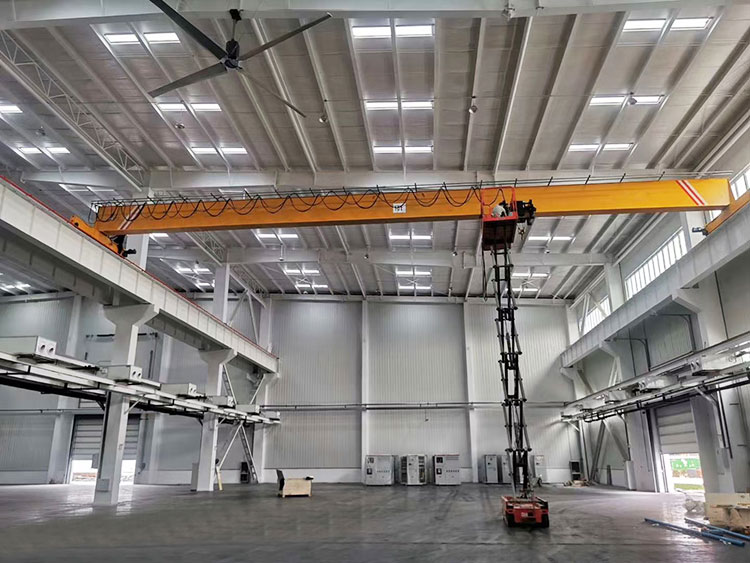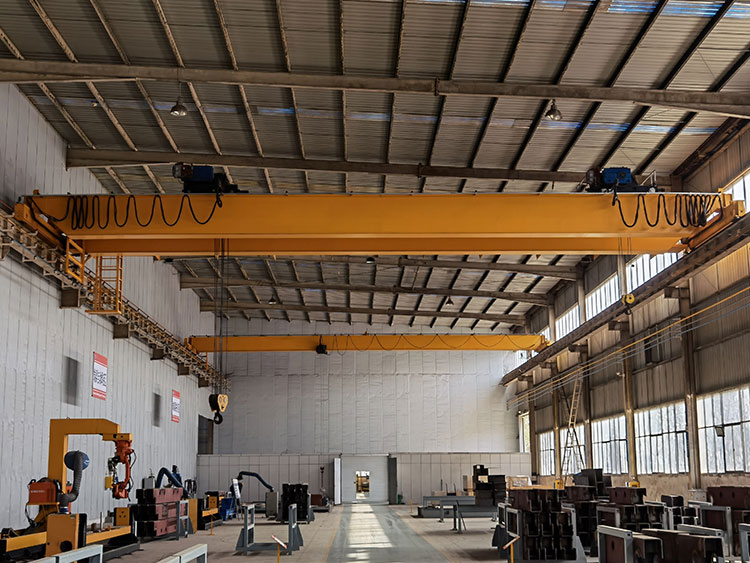When considering the purchase of an overhead crane with a lifting capacity between 10 and 50 tons, it’s crucial to understand how various factors impact its price. Overhead cranes are significant investments for businesses, particularly those in manufacturing, logistics, construction, and other heavy-duty industries. Whether you’re looking to buy a 10-ton overhead crane for a small workshop or a 50-ton model for heavy-duty lifting in a large industrial environment, knowing the price breakdown can help you make an informed decision.
In this article, we will explore the key components that influence the price of overhead crane and how they contribute to the overall cost of your purchase.

1. Crane Capacity: How Load Rating Affects Price
The most apparent factor affecting the price of an overhead crane is its load capacity. As a general rule, the larger the load capacity, the higher the price. Cranes designed for lifting lighter loads (10 tons) are less expensive than those built for heavy-duty lifting (50 tons). This is due to the heavier-duty materials and components required for high-capacity cranes, as well as the engineering and design complexities involved in ensuring safety and reliability under heavy loads.
A 10-ton overhead crane will typically use lighter materials and smaller motors, whereas a 50-ton crane will need reinforced structural elements like stronger beams, higher-rated motors, and more advanced lifting mechanisms.
The capacity is determined by the nature of the crane’s components, including the hoist, the bridge, and the trolley, all of which are scaled to handle specific weight ranges. The higher the tonnage, the more robust the crane needs to be, thus driving up the cost.
2. Span and Lifting Height: Impact on Crane Design
Another critical factor influencing the 10 ton to 50 ton overhead crane price is the span and lifting height. The span refers to the distance between the crane’s supporting rails or legs, while the lifting height is the maximum distance the crane can lift its load from the ground. Both of these dimensions are tailored to specific requirements depending on the layout of your facility and the materials you intend to move.
-
Span: A longer span requires a larger crane structure to maintain stability and support heavier loads, which increases both the material and manufacturing costs. A crane with a span of 10 meters will naturally cost less than one with a span of 25 meters, even if both have the same load capacity.
-
Lifting Height: Cranes with higher lifting heights require longer hoist mechanisms, more powerful motors, and advanced engineering to maintain the crane’s stability. Cranes designed for higher lifting heights may also require more robust safety systems, further increasing the cost.
For example, a 10-ton crane with a span of 8 meters and a lifting height of 6 meters will generally cost less than a 10-ton crane with a span of 20 meters and a lifting height of 12 meters, even though both cranes have the same load rating.

3. Type of Crane: Single Girder vs. Double Girder
Overhead cranes can be classified into single girder and double girder designs, and this distinction has a direct impact on the 10 ton overhead crane price.
-
Single Girder Cranes: These cranes use a single girder beam for supporting the hoist and trolley. They are generally more affordable than double girder cranes due to their simpler design, lighter structure, and fewer materials needed. Single girder cranes are often used for lighter loads, lower lifting heights, and smaller spans. They are ideal for warehouses and small-scale operations.
-
Double Girder Cranes: A double girder crane uses two beams for greater strength and stability, allowing for higher lifting capacities, longer spans, and increased safety. Double girder cranes are more expensive due to their complexity and the materials needed for their construction. They are commonly used in larger facilities with more demanding lifting tasks.
For instance, a 10-ton single girder crane may cost less than a 10-ton double girder crane with similar dimensions because of the difference in structural requirements and the need for additional components.
4. Control System: Manual vs. Automated
The control system is another important factor that can significantly impact the price of an overhead crane. There are a variety of control systems available, ranging from basic manual control to highly automated, computerized systems.
-
Manual Control: Traditional manual control systems (such as pendant controls) are usually less expensive and easier to operate but require more labor input and may not offer the same level of precision and safety as automated systems. They are often used in smaller operations or where lifting requirements are not highly complex.
-
Automated Control Systems: Overhead cranes with automated control systems, including radio remote controls or integrated PLC (Programmable Logic Controller) systems, are more expensive. These systems provide better precision, safety, and convenience, allowing operators to control the crane remotely and reduce the risk of accidents. Additionally, automated systems may offer features like load monitoring, data logging, and advanced safety functions, all of which add to the cost.
The price of a 10-ton crane with a basic manual control system will be less than a similar crane with an advanced automated control system, making it essential to assess the operational needs of your facility before choosing a control system.
5. Hoist Mechanism: Chain vs. Wire Rope
The hoist mechanism is another critical component that influences the overall price of an overhead crane. Hoists come in two main types: chain hoists and wire rope hoists. The choice of hoist mechanism depends on the intended application, load capacity, and the type of material being handled.
-
Chain Hoists: Chain hoists are generally more affordable and are typically used for lighter loads. They are often used in applications requiring lower lifting heights and less frequent use.
-
Wire Rope Hoists: For heavier loads and higher lifting heights, wire rope hoists are more suitable. These hoists are more expensive but are capable of handling larger loads and provide greater durability and reliability. They are often used in industries such as construction, steel manufacturing, and heavy machinery.
For example, a 10-ton overhead crane with a chain hoist may be less expensive than a similar crane with a wire rope hoist, as the wire rope hoist requires stronger components and additional engineering for safety.
6. Safety Features: How They Add to the Cost
Safety is paramount in any crane operation, and the inclusion of advanced safety features can add to the overall cost of an overhead crane. Some of the key safety features that may be included in higher-end cranes are:
-
Anti-collision systems to prevent cranes from colliding with objects or other cranes.
-
Overload protection to prevent the crane from lifting more than its rated capacity.
-
Emergency stop buttons to quickly halt crane operation in the event of a malfunction.
-
Variable frequency drives for smooth and precise control, which can reduce wear and tear on the crane.
These features improve the operational safety and efficiency of the crane, but they also contribute to the overall eot crane price.
7. Material and Manufacturing Quality
The quality of materials used in the construction of the crane, including steel quality, electrical components, and coatings, also plays a significant role in determining the price. High-quality materials ensure the crane’s durability and performance over time, but they come at a higher cost.
Crane manufacturers that use premium materials and employ advanced manufacturing processes (such as precision welding and high-strength steel) will generally produce more expensive cranes, but they will also offer longer lifespans and reduced maintenance costs.
8. Installation and After-Sales Support
The installation and after-sales support provided by the manufacturer or supplier are additional factors that can affect the total cost. Some manufacturers offer free or discounted installation services, while others charge extra for on-site assembly. Additionally, the cost of ongoing maintenance, spare parts, and service contracts should be factored into the overall cost of ownership.
Conclusion
When purchasing a 10-50 ton overhead crane, it’s essential to consider all the factors that contribute to the price. From the crane’s load capacity, span, and lifting height to the type of hoist mechanism, control system, and safety features, each component plays a significant role in the total cost. By understanding the price breakdown and aligning it with your specific operational needs, you can ensure that you invest in an overhead crane that meets both your performance and budgetary requirements.
Choosing the right crane involves balancing the initial cost with the long-term benefits of efficiency, safety, and reliability. As with any significant investment, it’s always recommended to seek advice from experienced crane suppliers or manufacturers to get the best deal tailored to your business needs.
